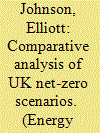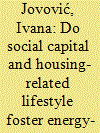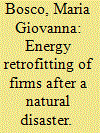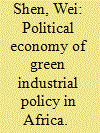|
|
|
Sort Order |
|
|
|
Items / Page
|
|
|
|
|
|
|
| Srl | Item |
| 1 |
ID:
191321


|
|
|
|
|
| Summary/Abstract |
Whether biomass energy should be regarded as a clean energy or not is still a contentious issue in the literature. Biomass energy comes from different sources, each having the possibility to affect the environment differently. Accounting for this heterogeneity to avoid any aggregation bias, this study examines the impact of biomass energy on environmental quality in the U.S. from the standpoints of consumption and production, different biomass sources, asymmetric changes, and threshold effects. We find that the adverse environmental impact of biomass energy production is higher than its consumption. Moreover, except in the long-run where the impact of negative changes in biomass energy consumption overshadows its positive changes, positive changes in biomass energy consumption and production degrade the environment more than negative changes in biomass energy consumption. The threshold analysis further reveals that the production and consumption of biomass energy beyond some levels reduces environmental quality, unlike when they are minimal. Finally, wood is the most environmentally unfriendly biomass energy source, whereas biodiesel is the most environmentally friendly. The policy implications of these findings are crucial for environmental sustainability, climate change mitigation, and efficient production and use of biomass.
|
|
|
|
|
|
|
|
|
|
|
|
|
|
|
|
| 2 |
ID:
191316


|
|
|
|
|
| Summary/Abstract |
Energy tariff plays an important role in ensuring affordable energy availability in a country. Various developed countries have incorporated social welfare indicators in their electricity tariff structures to support their lower-income groups. The developing countries, riddled with multifaceted challenges in their energy value chains have not taken care of access to affordable energy for the poor (SDG7). Existing literature on developing countries and Pakistan has not sufficiently highlighted the drivers of social welfare mechanisms in the electricity tariff structure for poor households. This study aims at examining the factors contributing to the decline in social welfare for electricity household consumers in Pakistan. The study has utilized a mixed analytical approach, incorporating NVIVO analysis and Q methodology. The results highlighted a lack of regulatory performance, political influence, suboptimal governance, and financial constraints as barriers to enhancing the residential consumer's social welfare in Pakistan. Our findings may help to devise and revise the policies such as power sector subsidies for the determination of better electricity tariffs for the poorer segment of society in Pakistan. Other developing countries may also benefit by improving the relevant policy circumstances (main barriers from this study) of the electricity subsidies for poor households.
|
|
|
|
|
|
|
|
|
|
|
|
|
|
|
|
| 3 |
ID:
191310


|
|
|
|
|
| Summary/Abstract |
The large-scale deployments of Carbon Capture and Storage (CCS) and hydrogen (H2) require the installation of costly carbon dioxide (CO2) and H2 pipeline infrastructures. As the future demands for CO2 and H2 pipeline transportation are expected to increase substantially, this paper examines the economics of installing adequately oversized infrastructures. We analytically show that the underlying engineering equations de facto define Cobb-Douglas production functions for both fluids. We then use these production functions to determine the cost-minimizing decisions of a pipeline operator and infer the optimal ratio of oversizing. From a policymaking perspective, this ratio indicates whether the level of oversizing envisioned by the operator is consistent with its expectations of future demand (and thus, by contrast, whether it is attempting to overcapitalize and exploit a regulatory flaw). As the anticipations of the operator may fail to materialize, we opt for a minimax regret perspective and compare the performances of the operator's investment decisions under alternative demand trajectories. Our study shows that the conservative recommendation to build for the proven demand only is systematically regret-maximizing. Consequently, an infrastructure push would likely contribute to overcoming the chicken and egg problem and thus support the large-scale deployment of these emerging technologies.
|
|
|
|
|
|
|
|
|
|
|
|
|
|
|
|
| 4 |
ID:
191311


|
|
|
|
|
| Summary/Abstract |
Western Denmark is a separate bidding area in the North-Western European power market, Nord Pool. Wind power now exceeds 50% of production annually in Western Denmark. Hourly market data from 1999 onwards are publicly available from the Danish TSO. In this paper, we analyse these data for 2009–2021. Until the energy crisis began in 2021, the Nordic power market has shown relatively stable prices. While extreme events are moderately increasing, the value factor of wind is stable. Thus, the current infrastructure – flexible power plants, interconnectors and electrification of district heating – and market organisation can manage the amount of wind power installed. In other words: 2009–2021 show a well-functioning market economy of dispatch, operating on top of a planned economy of investment.
|
|
|
|
|
|
|
|
|
|
|
|
|
|
|
|
| 5 |
ID:
191330


|
|
|
|
|
| Summary/Abstract |
Space heating in China relies heavily on fossil fuels that cause heavy air pollution and greenhouse gas emissions. The clean heating policy began in 2013 to improve air quality and is now expanding to clean and low-carbon heating (CLCH) for the 2030 carbon dioxide peaking targets. However, few studies have focused on the transformation of China's heating sector over the past decade. The heating areas in China are categorized into urban areas in Northern China, town areas in Northern China, rural areas in Northern China, and regions in Southern China. Six types of CLCH technologies with the highest potential and prospects were reviewed and summarized. In northern urban and town areas, waste heat utilization could help achieve zero-carbon district heating. However, energy-efficient and affordable distributed (household) heating technologies should be promoted in rural and southern areas. In addition, the energy-efficient retrofit of buildings is crucial for reducing heating energy demand and should be given priority. This review provides an overview of CLCH development in China and can be used as a reference for other countries to develop heating strategies.
|
|
|
|
|
|
|
|
|
|
|
|
|
|
|
|
| 6 |
ID:
191309


|
|
|
|
|
| Summary/Abstract |
Final energy demand in the UK has remained relatively constant since the 1970s. However, most of the scenarios that model pathways to achieve the UK's net-zero greenhouse gas emissions by 2050 indicate that energy demand reduction (EDR) will be an important pillar of climate change mitigation. Despite this, the UK Government has no clearly defined strategy to reduce demand. This comparative analysis explores the role of EDR across twelve UK-based climate scenarios from four organisations that estimate changes in carbon emission and energy consumption from 2020 to 2050. We focus on changes in final demand across the economy, assessing the scale of ambition and the implications for the rest of the energy system in the context of net-zero. All the pathways explored achieve reductions of at least 32.8% in total final energy demand from 2020 to 2050, suggesting that this is the minimum level of demand reduction required to achieve the development and rollout of the supply side technologies necessary to decarbonise the energy system. Reductions in total final demand of up to 52% are demonstrated. We find that pathways with higher levels of EDR mitigate against technological challenges, such as scaling up renewable energy capacities, are less reliant on carbon-dioxide removal technologies and require less investment – but are characterised by higher levels of social change.
|
|
|
|
|
|
|
|
|
|
|
|
|
|
|
|
| 7 |
ID:
191327


|
|
|
|
|
| Summary/Abstract |
The energy transition requires substantial investments. However, deep uncertainty – a situation where probabilities of outcomes and possibly the outcomes themselves are unknown – can deter investment in the energy transition. This is demonstrated based on three cases covering the sectors power generation and transportation: investment in (i) a coal-fired power plant, (ii) offshore wind, and (iii) electric vehicles. These cases illustrate key issues related to deep uncertainty: The interplay of multiple sources of uncertainty within highly complex investments can lead to deep uncertainty. Further, deep uncertainty related to policy and technologies delays and distorts investment decision-making. Based on the findings from the cases, we derive recommendations for policymakers. In the case of technology uncertainties, the policymaker can widely support technology alternatives or offer risk mitigating instruments to reduce firms’ costs of making the wrong decision. Supporting highly uncertain early-stage investments yields additional social benefits by reducing uncertainty for future investments due to learning effects. Overall, policymakers need to signal credible long-term commitment to the energy transition, particularly in those cases, where policy itself is a major source of uncertainty for firms and investors.
|
|
|
|
|
|
|
|
|
|
|
|
|
|
|
|
| 8 |
ID:
191314


|
|
|
|
|
| Summary/Abstract |
In 2019, 3.9 million French residential customers subscribed to 100% green electricity offers. These offers are based on guarantees of origin (GOs), the electricity-tracking system in the European Union. Based on an analysis of the French GO registry, this paper assesses whether French green electricity consumers contribute to the increase of renewable electricity generation capacity. Theoretically, green consumers may have a direct or indirect impact on additional investments. Our results show that, in practice, the GO system benefits almost exclusively to large old French hydro plants. To make the GO system more effective in raising renewable energy capacity, two options are discussed: limiting the issuing of GOs to new production devices only or informing consumers via additionality criteria labelling.
|
|
|
|
|
|
|
|
|
|
|
|
|
|
|
|
| 9 |
ID:
191319


|
|
|
|
|
| Summary/Abstract |
This article explores the role of social capital and housing-related lifestyle in fostering energy-efficient retrofits and sheds additional light on potential barriers and drivers to energy-efficient retrofits in households. Using data from an online survey conducted in August 2020, a retrospective panel data set comprised of 2537 households from the EU member state of Slovenia is constructed. The results of discrete choice models with random effects show that high income levels, the respondent’s age, the age of the dwelling, previously performed retrofits, and the availability of subsidies are drivers, while high regional temperatures and negative GDP growth are barriers to energy-efficient retrofits. We find that social capital and housing-related lifestyle are also important determinants of energy-efficient retrofits. Certain dimensions of housing-related lifestyle, such as energy-saving behavior and a proclivity for ‘do-it-yourself’ home maintenance and repairs, act as drivers of energy-efficient retrofits. The same is true for variables related to social capital, namely, ease of agreement among residents and the formal organization of the building. A policy mix of further education and information campaigns, subsidies, and measures that affect the formal organization of the building and promote community building is required to address the various barriers to energy-efficient retrofits.
|
|
|
|
|
|
|
|
|
|
|
|
|
|
|
|
| 10 |
ID:
191317


|
|
|
|
|
| Summary/Abstract |
In 2012, an earthquake struck one of Italy's most productive and dynamic areas, the Emilia-Romagna region. Just as policy makers are today considering green and climate-conscious investments to recover from the COVID-19 pandemic, in 2012, the regional government granted specific energy retrofitting contributions to manufacturing and service firms affected by the seismic event. Through a panel data analysis, we evaluate the impact of such energy policy measures on firm-level labour productivity to assess the presence of non-zero multipliers. We find that energy retrofitting through regional aids positively affected firms' labour productivity. We discuss the energy and economic policy implications of such intervention in the current framework of fiscal recovery packages.
|
|
|
|
|
|
|
|
|
|
|
|
|
|
|
|
| 11 |
ID:
191322


|
|
|
|
|
| Summary/Abstract |
Under the pressure for new policy and socio-ecological transformation, this work evaluates the future (2020–2050) GHG emissions, considering a likely range of electric energy growth scenarios in the world’s current energy system. An integrated model accounts for different penetration strategies of renewable energies, technological advancements, and variations in the fuel/renewables mix. Data of actual renewable/fossil share, GHG emission factors, and technology indicators, as plant load factors, were assumed from the Italian scenario. The study reveals that regardless of the current electric energy demand for the future, the transition to a massive penetration share of renewables as unique GHG reduction strategy will only partially abate the level of GHGs, and the zero-emission targets are definitely not feasible. A relevant result is the evaluation of future green power capacity, to satisfy the worldwide electrical energy demand. The scenarios foresee an unprecedented rate of the installation of generation plants from renewable sources, accompanied by a steep year-by-year variation of the required power capacity in operation. This prediction, in the temporal front chosen for this survey, poses the problem of the technological readiness of many conversion technologies, which makes it difficult to guarantee that renewable penetration programs can be matched with their technical feasibility.
|
|
|
|
|
|
|
|
|
|
|
|
|
|
|
|
| 12 |
ID:
191313


|
|
|
|
|
| Summary/Abstract |
Donald Trump’s use of Twitter was unprecedented. Many of Trump’s strong statements in reference to the U.S. oil & gas industry were intended to advertise his domestic policy agenda aimed at supporting re-industrialization and investment. Did his Twitter messages actually reach domestic oil producers, refiners and transport operators, or rather speculators willing to financially gamble on new information sources? To answer, we look at the WTI-Brent spread, which commonly reflects supply bottlenecks in the U.S. crude oil sector. We use a nonlinear modelling approach where Trump’s tweets are allowed to impact the persistence of market volatility regimes. We find that some of his tweets increase the likelihood of wider spreads, undermining the global status of the WTI benchmark. There is also a negative market impact on proxies for liquidity and speculative activity. Policy recommendations are outlined to counteract the consequences of market speculative behaviour driven by political noise.
|
|
|
|
|
|
|
|
|
|
|
|
|
|
|
|
| 13 |
ID:
191315


|
|
|
|
|
| Summary/Abstract |
To comply with international climate targets, India will eventually need to phase out coal-fired power plants and substantially increase the use of solar-PV and wind power. Winners and losers of this transformation will not be distributed equally across the country, which potentially holds severe implications for the feasibility of the transformation. In an effort to understand political economy constraints from adversely impacted key societal groups, we discuss how Indian states would be affected in terms of distributional implications for households, industrial competitiveness and employment. We examine the effects of phasing-out of energy subsidies and carbon pricing (USD 40 per ton CO2) on household incomes. We likewise analyze employment effects of ramping-up renewables and phasing-out of coal-fired power plants. Finally, we assess the impacts of carbon pricing on key industries. Our findings suggest that adverse impacts are strongly concentrated in Eastern, less wealthy, coal- mining states, which would face employment losses with pressure on poor households and energy intensive industries. Employment creation through deployment of renewables would, however, be more dispersed across India's Western and Central states. Complementary policies, such as recycling carbon tax revenues, will be necessary to avoid deepening regional disparities and increase acceptance from adversely impacted regions.
|
|
|
|
|
|
|
|
|
|
|
|
|
|
|
|
| 14 |
ID:
191323


|
|
|
|
|
| Summary/Abstract |
Access to electricity and clean, modern cooking technologies is still a concern in developing countries. However, the literature on the determinants of energy poverty seems to neglect the role of international sanctions. This study establishes, for the first time, the empirical relationship between international sanctions and energy poverty in target developing countries. We use data from a large panel of 97 countries regularly sanctioned over the period 1996–2019. Using the fixed effects method and logistic regression, we find that international sanctions increase energy poverty in the target countries. Specifically, the imposition of UN, EU, US, unilateral and plurilateral sanctions leads to a reduction in energy consumption, access to electricity, and clean and modern cooking technologies. For robustness, alternative sanctions measures (travel, financial, trade, military, arms, economic, non-economic, and intensity), additional control variables, as well as an alternative estimation strategy, were considered. In order to provide robust policy recommendations, we explain the mechanisms by which international sanctions affect energy poverty, including human capital, energy efficiency, income inequality, and economic growth.
|
|
|
|
|
|
|
|
|
|
|
|
|
|
|
|
| 15 |
ID:
191329


|
|
|
|
|
| Summary/Abstract |
Rather than by an invisible hand, many industries are kick-started by a government policy. Despite little robust evidence, local content requirements are increasingly used to incentivize domestic manufacturing if imports are cheaper. To examine the effect of local content, we explore an unintended quasi-policy-experiment. Starting in 2013, the Indian government simultaneously held solar auctions with and without local content, providing an otherwise unobserved counterfactual. We digitize the results from the 41 auctions worth 8.65 billion $ in solar module demand and collect annual revenue and solar patents of the 113 participating firms between 2004–2020. For causal identification, we compare winners of local content with similar open auction winners in a staggered difference-in-difference estimation. While we observe an insignificant increase in the same and the following year after firms win LCR auctions, overall, we find winning local content auctions does not significantly increase firms’ solar patents or sales. We identify three reasons why the policy did not create stronger, lasting effects. First, local content did not create sufficient production to enable learning by doing. Second, local content did not generate enough revenue for re-investment into R&D. Third, local content reduced competition in auctions. The analysis underlines the predicament countries face as open auction winners, despite having won 9 times as much capacity, do not patent much (more).
|
|
|
|
|
|
|
|
|
|
|
|
|
|
|
|
| 16 |
ID:
191325


|
|
|
|
|
| Summary/Abstract |
Various international agreements and mechanisms are established to mitigate climate change by setting targets to reduce greenhouse gas emissions. Türkiye plans to reduce the emissions by 41% from the Business as Usual level in 2030 and set its net zero target. Thus, reducing the emissions of the electricity and heat production sector, primarily driven by fossil fuels, will help achieve its emission target. This study aims to provide a pathway for designing the Turkish public electricity and heat production sector and its policy reflection to achieve a net zero emissions target for 2053. Türkiye's electricity sector is analyzed based on three scenarios with different emission pathways between 2021 and 2053. The model results show a tremendous increase in installed capacity, generation and cumulative investment costs to achieve the net zero target. However, a minor increase in generation cost, emissions and installed capacity is expected when a reduction of 40% from the Business as Usual level is estimated. These results reveal the need for significant changes in its energy policies to pave the way for substantial investment in renewable and nuclear energy and power plants with carbon capture and storage to achieve the net zero target.
|
|
|
|
|
|
|
|
|
|
|
|
|
|
|
|
| 17 |
ID:
191328


|
|
|
|
|
| Summary/Abstract |
Like many countries in Africa, Ethiopia has been promoting renewable energy deployment via a number of policies and policy instruments, including through a a public-private partnership scheme. However, these newly introduced green industrial policies (GIPs) encountered obstacles leading to delays in project planning and implementation. In this paper, we argue that the coordination failures among key policy stakeholders, both internally and externally, is a central cause for the ineffective implementation of GIPs in Ethiopia. Our analysis shows that adequate sectoral expertise and coordination capacity of the steering agency are critical, as managing multiple conflicts of interest and preferences among key stakeholders are inevitable when GIPs are introduced. In addition, GIPs often contain multiple objectives ranging from green industrialisation, environmental or climate impacts, and social or economic benefits. Yet the trade-offs among these objectives during the policy implementation should be well recognised and a clearly defined priority is required, which again demands a capable and autonomous steering agency in the host country.
|
|
|
|
|
|
|
|
|
|
|
|
|
|
|
|
| 18 |
ID:
191312


|
|
|
|
|
| Summary/Abstract |
This paper investigates the impacts of governmental support strategies on rival bioenergy and conventional energy supply chains in the presence of cap-and-trade regulations using a game-theoretic approach. The role of government in reducing carbon emissions and increasing carbon capture and storage (CCS) is explored and compared in three scenarios: NO-Support (N), Subsidy on investment (C), and FIT subsidy (I). In the bioenergy supply chain, the bioenergy manufacturer determines the wholesale electricity price and the level of CCS efforts, and the 3 PL company specifies the level of carbon emission reduction efforts. The decision variable of the conventional energy supply chain is the wholesale electricity price. In addition to the carbon cap, the government must decide the rate of its contribution to CCS and 3 PL costs in scenario C and the Feed-In Tariff subsidy rate in the scenario I. The results show that in the presence of cap-and-trade regulations, all examined governmental support strategies, especially those in scenario C, can significantly improve the profits of bioenergy supply chain members while sustainable development goals. In addition, Scenario C is more effective in incentivizing the supply chain members to increase CCS and reduce carbon emission levels among the three scenarios.
|
|
|
|
|
|
|
|
|
|
|
|
|
|
|
|
| 19 |
ID:
191318


|
|
|
|
|
| Summary/Abstract |
The purpose of this paper is to update and extend prior studies that examine the impact of onshore wind turbines on property values. Our data come from Massachusetts and Rhode Island, two states that are population dense and rapidly transitioning to renewable energy. We use a difference-in-differences identification strategy with treatment defined by proximity. In contrast to prior research in these states, our results suggest that property values decline when wind turbines are built. These negative impacts are mostly confined to properties within 1 km of a turbine. However, we delve deeper into these aggregate results by examining how treatment effects vary for different regions and how treatment effects vary over time. Importantly, we find that the negative impacts found are almost entirely driven by Cape Cod and Nantucket, Massachusetts. We estimate small and typically insignificant effects for other regions of Massachusetts and Rhode Island. Further, we estimate dynamic models that allow for heterogeneous treatment effects in time since construction. These results suggest that negative impacts abate over time, though in the case of Cape Cod and Nantucket never go to zero. Possible explanations for our complex findings include contagion from opposition to Cape Wind, preference-based sorting, and acclimatization.
|
|
|
|
|
|
|
|
|
|
|
|
|
|
|
|
| 20 |
ID:
191320


|
|
|
|
|
| Summary/Abstract |
Energy diversification is critically important from an economic, political and environmental point of view. In this research, we try to investigate the role of energy diversification for sustainable development in Asia Pacific Economic Cooperation or APEC member countries. We utilize data from different sources which range from 1990 to 2020. Apart from energy diversification, other independent variables such as public sector corruption, ICT, economic globalization and social globalization are utilized according to the theory and empirical literatures which utilize these parameters in order to see how growth or environment of an economy is affected. The study implements second generation econometric methodologies in order to tackle the cross sectional dependence issue among the countries. The result reveals that energy diversification positively and significantly affect sustainable development in APEC nations. ICT and economic globalization were also found to be positively affecting the sustainable development. However, social globalization negatively affected the sustainable development while the effect of public sector corruption was not significant. Bidirectional causality was revealed between sustainable development and energy diversification. The study recommends diversifying energy sources for achieving the sustainable development goals (SDGs) agenda for these economies.
|
|
|
|
|
|
|
|
|
|
|
|
|
|
|
|
|
|
|
|
|